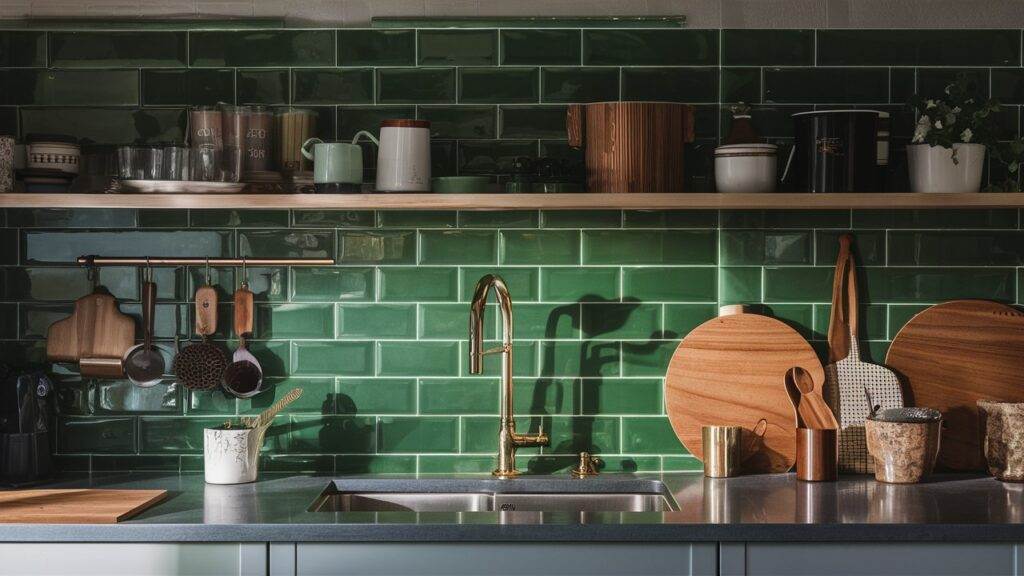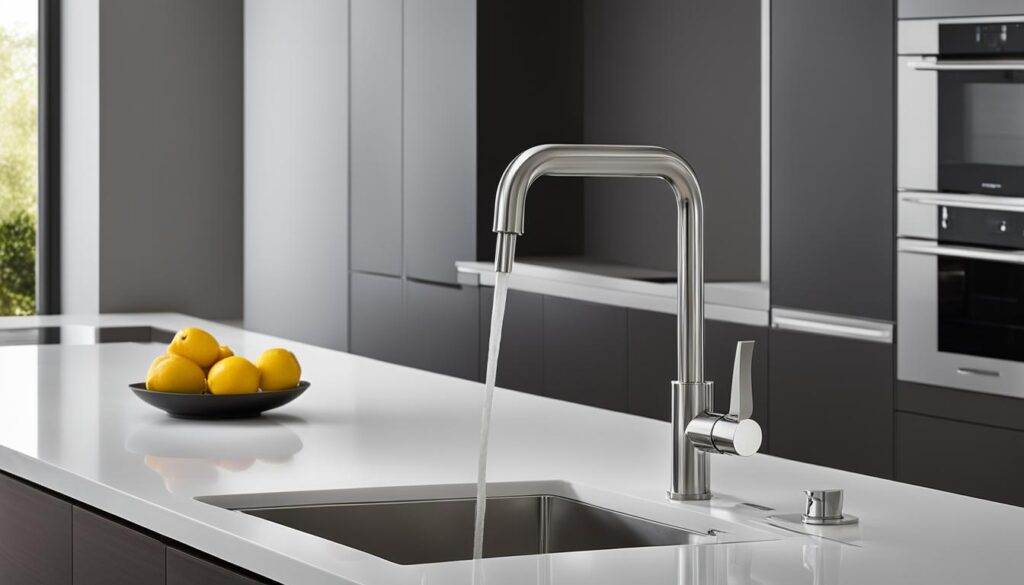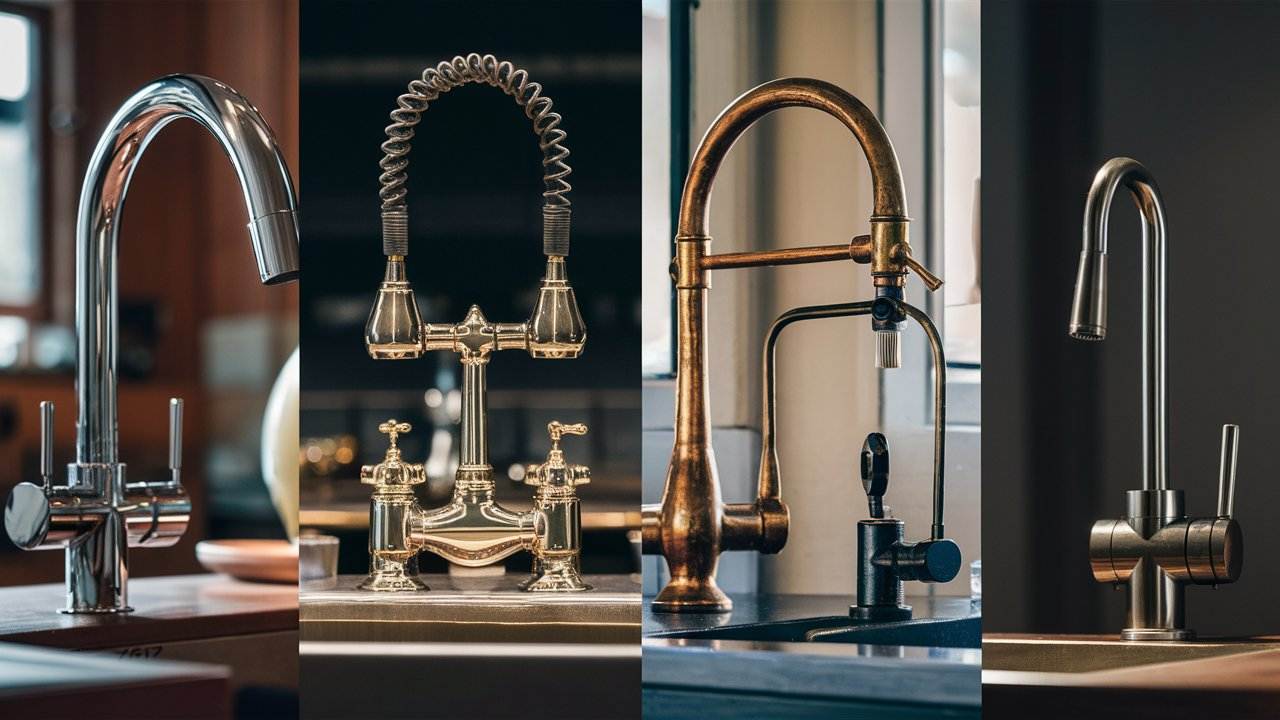Get a comprehensive look at the different kitchen sink taps available today. Understand the various options, including tap styles and functions, to make an informed choice for your kitchen.
Common Types of Kitchen Sink Taps
Kitchen sink taps come in different styles and ways they work. Knowing about these types helps you choose one that fits your kitchen’s needs and looks nice too.
Pillar Taps
Pillar taps are a classic choice for many kitchens. They have two separate controls—one for hot water and one for cold water. These taps are great for traditional or vintage-style kitchens, but they can also fit into modern designs if done right. Inside, they usually use compression washers or cartridge systems to control the flow and temperature of water.
Key Features:
- Design: Traditional style
- Controls: Separate hot and cold
- Mechanism: Compression washers or cartridges
Mixer Taps
Mixer taps blend hot and cold water from a single spout. This makes them super handy because you can easily adjust the temperature with just one lever. They come in many designs, from sleek modern looks to more classic styles, so you can find one that matches your kitchen decor.
Advantages:
- Ease of Use: One control lever
- Versatility: Fits different kitchen styles
- Temperature Control: Quick adjustments
Wall-Mounted Taps
Wall-mounted taps attach directly to the wall above the sink instead of sitting on the counter. This saves space and gives a unique look to your kitchen. They’re often used in smaller kitchens or ones with specific design themes. Make sure they fit well with your sink type and plumbing before choosing them.
Benefits:
- Space-Saving: Great for small areas
- Aesthetic Appeal: Unique design
- Installation Flexibility: Needs proper plumbing setup
Monobloc Taps
Monobloc (or single-handle) taps have a simple design where both hot and cold water controls are in one handle. This makes them easy to use while adding a modern touch to your kitchen decor. You can find monobloc designs in various styles—from simple to fancy—giving homeowners plenty of options.
Characteristics:
- Design Variety: Simple to fancy
- User-Friendly: Single handle operation
- Modern Touch: Enhances kitchen look
Specialty Taps for Specific Kitchen Needs
Some situations need special kitchen faucets designed just for those needs:
Commercial Kitchen Taps
Commercial-grade faucets are made tough for busy kitchens, like those in restaurants. They usually have high-arcing spouts that give you enough space for big pots while being strong enough to handle daily use.
Features:
- Durability: Made for heavy use
- High-Arcing Spouts: Plenty of clearance
- Robust Materials: Built to last
Low-Pressure Taps for Rural Areas
For homes in rural places where water pressure is often low, low-pressure faucets help keep things running smoothly without losing any function. These faucets might have larger openings or adjustable flow rates.
Considerations:
- Performance Optimization: Works well with low pressure
- Adjustable Flow Rates: Customizable usage
- Larger Openings: Better efficiency
Pull-out or pull-down faucet designs let you reach farther when washing dishes. You can aim the water exactly where it’s needed—like rinsing veggies or filling up pots on the counter. Many models even come with spray features that make them even more useful.
Advantages:
- Extended Reach: Makes washing easier
- Versatile Spray Functions: Multiple uses
- User-Friendly Design: Easy operation
Understanding these common types of kitchen sink taps helps you pick the right one that suits your needs while making your cooking space more functional and stylish!
Choosing the Right Tap Style for Your Kitchen
When you’re picking a tap style for your kitchen, think about how it looks and how it works. The right kitchen tap can make your space feel better and help you do tasks more easily. There are three main types of kitchen tap styles to consider:
Contemporary Tap Styles
Contemporary taps usually have:
- Sleek Lines: These taps look clean and fit well in modern kitchens.
- Finishes: Common choices are chrome and matte black, which add a stylish touch.
These designs focus on simplicity, making them great for a fresh kitchen vibe.
Traditional Tap Styles
Traditional taps bring a classic charm. Key features include:
- Ornate Details: Many have fancy designs that give off a vintage feel.
- Finishes: Options like brushed nickel or bronze work perfectly in rustic or vintage-themed kitchens.
Choosing traditional taps can add warmth and character to your cooking space.
Modern Tap Styles
Modern taps mix cool technology with nice design. Features to check out include:
- Touchless Operation: This is super handy and keeps things clean.
- Pull-Out Sprayers: These make it easy to rinse dishes or fill pots.
These taps not only look awesome but also help make cooking easier.
In the end, pick a style that matches your kitchen’s look to boost both its function and appearance.
Choosing the right finish not only goes well with your current decor but also helps ensure it lasts longer and is easy to clean. Think about how each finish will match with other parts of your kitchen, like cabinet hardware or appliances, so everything looks good together.
Knowing about different kitchen tap styles and finishes is key when planning your kitchen decor ideas. By thinking carefully about these choices, you can find stylish tap options that improve both the look and use of your space.
Single-Handle vs. Two-Handle- Selecting the Best Tap Operation
When picking between single-handle kitchen taps and two-handle kitchen taps, there are a few things to think about. Knowing these differences can help you choose what fits your needs best.
Ease of Use
- Single-Handle Taps: These have one lever that controls both hot and cold water. This makes it easy to adjust the temperature quickly, which is great when you’re busy cooking.
- Two-Handle Taps: These have separate handles for hot and cold water, giving you more precise control over the temperature. But, they need both hands to operate, which can be less convenient.
Space Considerations
If your counter space is tight or if you have a smaller sink area, single-handle taps are usually more compact. They take up less room than the wider design of two-handle models.
Aesthetic Appeal
The style of your kitchen matters too:
- Modern Kitchens: Single-lever mixers often give a sleek look that fits well in contemporary spaces.
- Traditional Decor: Two-handled designs can enhance classic styles and work well with vintage themes.
Maintenance
Think about how much upkeep you’ll need:
- Single-Handle Taps: They usually have fewer parts that can wear out, making them easier to maintain.
- Two-Handle Taps: With more components, they might need repairs more often.
Choosing the right tap operation really comes down to what works best for you in terms of function and style.
Sensor Taps- Enhancing Hygiene and Convenience
Sensor taps are becoming popular in modern kitchens because they offer some cool benefits that make life easier.
Hygiene
One big plus of sensor taps is their touchless operation. This means you don’t have to touch the tap with dirty hands, cutting down on germs. It’s especially useful when handling raw food items, helping keep your cooking area clean.
Convenience
These taps turn on automatically when they sense motion nearby. This hands-free feature is perfect for busy cooks who want quick access to water without turning a handle manually.
Water Conservation
Many sensor tap models come with features that limit water flow when not in use. This helps save water overall—great for anyone looking to be eco-friendly!
Design Options
Sensor taps come in many styles:
- Contemporary Designs: Sleek looks that fit modern kitchens.
- Traditional Looks: Options that blend well with classic decor styles.
Installation Requirements
While putting in sensor taps might need some help from a professional due to electrical parts, many brands make it easy with user-friendly options. This way, you get all the benefits without too much hassle during installation.
Adding sensor technology into your kitchen not only boosts hygiene but also adds convenience—a win-win for any home!

Sink Compatibility- Matching Taps to Sink Types
When picking a tap for your kitchen sink, it’s super important to make sure it fits well. Different sink types need different tap styles so they work right and look good.
Single-bowl sinks
- Standard Mixer Tap: This one is easy to use and gives enough water flow.
- Single-Lever Kitchen Tap: A handy option that lets you adjust the water with just one hand.
Make sure the spout is tall enough for filling big pots and pans. You don’t want to struggle when you’re cooking!
Double-bowl sinks
- High-Arc Faucet: Perfect for reaching both sides easily.
- Bridge Tap: This adds style while being practical.
Look for taps with pull-out or pull-down features. They make washing dishes or filling large containers much easier.
For undermount sinks, which often have a sleek look, choose taps that are simple and stylish:
- Wall-Mounted Tap: This choice saves counter space and looks nice too.
A clean design helps keep your kitchen looking neat.
Water Pressure Considerations- Impact on Tap Performance
Water pressure plays a big role in how well your kitchen tap works. Knowing if you have high or low water pressure will help you pick the right tap.
If you have high water pressure:
High-Pressure Taps: These work great with strong water flow.
- They often come with adjustable spray patterns, making them useful in busy kitchens.
- Higher arc designs give more room for filling pots easily.
On the flip side, if you’re in an area with low water pressure, check out these options:
Low-Pressure Taps: Made to work well even when water supply is low.
- Compression washer taps can keep things running smoothly under tough conditions.
- Cartridge valve taps are also good picks for low-pressure situations.
Also, keeping the right water temperature is key for comfort. Look for mixer taps that let you adjust hot and cold easily. This way, you can get just the right temperature while saving energy!
By thinking about sink compatibility and your water pressure when choosing a kitchen tap, you’ll get better performance and longer-lasting fixtures.

Step-by-Step Guide to Installing a Kitchen Tap
Installing a kitchen tap can be an easy DIY project if you follow some simple steps. Before you start, gather all the tools and materials you’ll need, like a wrench, plumber’s tape, and your new tap. This guide will help you with your kitchen tap installation.
- Removing the Old Tap: First, turn off the water supply to avoid any leaks. Use a wrench to disconnect the water lines from the old tap. Carefully unscrew it from the sink and take it out.
- Installing the New Tap: Place your new tap in position according to its design (like single-handle or mixer). Secure it with screws that come in your kit.
- Connecting the Water Supply: Attach the water lines back to their correct spots on your new tap. Make sure all connections are tight but don’t overtighten them; this could damage the fittings.
- Check for Leaks: After turning on the water supply again, check for leaks around your new installation. If you see any issues, fix them right away to prevent water damage.
By following these steps, you can complete your DIY tap installation and enjoy a working kitchen sink without hassle.
Troubleshooting Common Kitchen Tap Issues
Even with proper installation and care, problems can happen with your kitchen taps over time. Here are some common issues and how to solve them:
- Leaking Taps: If your tap is leaking, it might just need new washers or cartridges inside. Check where it’s leaking—around the handle or spout—and replace what’s needed.
- Squeaky Taps: Hearing squeaks when using your tap? This usually means that moving parts need some lubrication or may need replacing.
- Clogged Taps: Over time, mineral deposits can build up and reduce water flow. Cleaning aerators regularly helps keep everything running smoothly.
Regular maintenance checks can help extend the life of your kitchen taps and make sure they work well while preventing costly repairs down the line.

